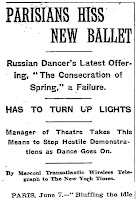Celebrating cultural highlights of 1913...
One hundred years ago at the
Théâtre des Champs-Élysées
with guest blogger Waldemar Hepstein
Guest contributor: Waldemar Hepstein is an artist for No Comprendo Press, a publisher of alternative comics. Hepstein’s work has appeared in the magazine Fidus and is collected in albums like 'Snork.’
Igor Stravinsky’s Le Sacre du Printemps (The Rite of Spring) is a thing of beauty,
terror, and wonder. Those who were
present at the notorious premiere performance at the Théâtre des Champs-Élysées in Paris on May
29, 1913, probably would not have predicted a long life for what many may have perceived
as barbaric noise. One hundred years
later, the Rite is still very much
with us, and indeed has become one of the most frequently performed and
recorded 20th century classical compositions. And in this case, the cliché holds true: It sounds as fresh today as when it was
first heard.
The original ballet was performed only a
handful of times, in both Paris and London. The important contributions of Stravinsky’s
collaborators, Vaslav Nijinsky (choreography) and Nicholas Roerich (scenery,
costume designs and co-scenarist) appeared to be lost to history for many years.
Then, in the 1980s, researchers
Millicent Hodson and Kenneth Archer pieced together a magnificent
reconstruction, first staged by the Joffrey Ballet in Chicago in 1987. It’s highly recommended for all admirers of
the piece, for even if Rite of Spring
may be slight on “plot” (its subtitle is simply “Tableaux of Pagan Life in Ancient
Russia”), the visuals and choreography greatly enhance appreciation of the
music.
In addition to various alternative
choreographies, the drama-packed music of the Rite has inspired other visuals. Undoubtedly the most famous example is
Disney’s Fantasia (1940), in which
the music is accompanied by a look at Earth’s prehistory. A sort of crash course in evolution is
followed by a visit with our planet’s early inhabitants, memorably including
the most exciting dinosaur fight since King
Kong (1933). Purists have reviled
Leopold Stokowski’s arrangement for Fantasia,
which heavily shortens and takes other signficant liberties with Stravinsky’s
score. On the other hand, there’s little
doubt that Fantasia helped introduce Le Sacre du Printemps to many people,
including myself. Needless to say, the
Disney animation is impeccable.
A more recent visualization is a digital
animation piece by Jay Bacal and Stephen Malikowski—a beautifully done,
colorful presentation somewhat reminiscent of Fantasia’s interlude with the “visual soundtrack.”
Once considered strange, avant-garde and
highbrow, the Rite of Spring is now
part of the “establishment,” with a secure place among the great compositions. The 100th anniversary is currently being
honored with a slew of performances, articles, seminars, re-issued recordings
and other tributes. Ol’ Igor would nod
his head in appreciation—and would probably take it as no more than his due! Long may the Rite continue to thunder.
Waldemar
Hepstein



No comments:
Post a Comment